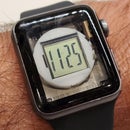Introduction: Dog Bowl Low-Water Alarm
We have two toy poodles that drink their water out of a small ceramic bowl located behind the bar area of our kitchen. Since it is out of sight we have to constantly monitor it to make sure the dogs don't run out of water. We are vigilant but there have been a couple of times over the years when we have found the bowl empty and caused some consternation. I have tried using those upside-down, bottle-style pet waterers but our smaller dog is very skittish and the bubbling sound scares her to death. I decided to make an unobtrusive, silent, low-water alarm to alert us when their bowl is low on water.
Step 1:
There are a lot of water alarms on the market but most are designed to alert you when water is detected such as when a washing machine leaks or a basement floods. The ones that have a low-water alarm function have a float switch that would be too large for my dogs' small bowl and they usually have some kind of buzzer. I wanted an alarm that only goes off only when there is no water detected and I want it to be a silent, visual alarm that doesn't scare my smaller dog. I googled "low water alarm" and found this instructable that describes how to build exactly what I am looking for but when I started searching online to buy the parts I found this DIY Water Level Switch Sensor Controller Kit for a mere $3 but I didn't want to wait three weeks for it to arrive and then have to put it together so I did a little more searching I found this virtually identical, pre-assembled SMAKN DIY Water Level Switch Sensor Controller /Drainage control circuit board on Amazon for $12.
Step 2:
These simple low-water alarms use the conduction between two wire probes to detect the presence of water in lieu of a float switch. When the water drops below the level of the higher probe, there is no conduction and the alarm triggers. The SMAKN board can accept 9 to 12 volts DC and has a small DC/AC inverter that sends out a low voltage AC trigger to control either a electrically operated drain or pump or both since it has both high and low level probe inputs. I was only concerned with the low-level input and wanted to use a flashing DC-powered LED so the AC trigger wasn't going to work for my purposes.
Step 3:
I tested the board using 12V DC and while the low water level output was triggered I used my multimeter to discover two contact points under the DC/AC inverter that provide 10V DC which is perfect for driving a 12V LED. I bought a 5mm 12V red flashing LED to use for my visual alarm.
Step 4:
I bought a Hammond 1591MBK project box that looked like the circuit board would fit into perfectly. The board was just a hair too wide so I ran the edges of the board along a metal file until it slipped into the box. The only problem was that the capacitor was too tall to accommodate the lid so I bought a replacement 16V 2200uF capacitor and soldered it in without trimming the leads so it could be bent over.
Step 5:
I drilled a hole into one end of the project box to mount a 2.1mm x 5.5mm DC power jack (Size M) and a hole in the other end to mount a female RCA jack for the water level probe. There wasn't enough clearance for the power jack inside the box due to the screw terminal for the sensor wires so I de-soldered it and soldered the sensor leads directly to the board. I also clipped off the power and sensor LEDs since they weren't going to be seen and didn't want them generating any excess heat inside the sealed box.
Step 6:
I drilled a hole in the lid of the box and used a 5mm plastic LED holder to secure the 12V 5mm red flashing LED.
Step 7:
My original intent was to have the alarm on the counter and just run the sensor wire over the edge down to the bowl but since the alarm was going to be near a power outlet I used fish tape to pull the sensor wire (aka 24-Gauge speaker wire) up through the wall into the attic and then down to the outlet near their bowl so hopefully it would pass the WAF (Wife Approval Factor) test.
Step 8:
UPDATE: I have been using this water alarm for two years now and it still works great. In the picture above I stripped the insulation but it is unnecessary as the water makes contact with the ends of the wire just fine without stripping the insulation and risk contaminating the water with loose wire particles. Every few months the light will start blinking even though the bowl is full and the wire is submerged so I have to trim it back about a half inch because the anode wire has corroded inside the insulation and it resumes working just fine.
I was planning on clamping the sensor wire to the edge of the water bowl in some way but since the outlet is located right over the bowl it was unnecessary. I just stripped a few millimeters of insulation from the end of each wire and let it dangle in the water.
Step 9:
The alarm works perfectly. When the water level drops below the sensor wire the LED starts flashing. Thanks for looking!











